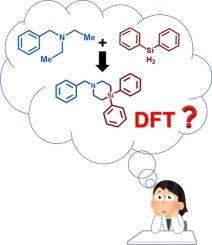B(C6F5)3催化n -苄基- n -乙基乙胺C(sp3)-H硅基化的DFT研究
IF 2.4
3区 化学
Q4 CHEMISTRY, PHYSICAL
引用次数: 0
摘要
利用M06-2×-D3/ma-def2-TZVP水平研究了n -苄基- n -乙基乙胺Csp3-H硅基化反应的机理。采用基于溶质电子密度的SMD方法模拟了对二甲苯的溶剂。计算结果表明,B(C6F5)3作为催化剂有助于完成Csp3-H的活化;B(C6F5)3和n -苄基- n -乙基乙胺可以完成n -苄基- n -乙基乙胺转化为烯烃衍生物,烯烃衍生物可以与质子化的二苯基硅烷反应得到加成中间体。最后,有两种途径(a和b)可以产生最终产物1-苄基-4,4-二苯基-1,4-偶氮硅烷。吉布斯自由能曲线表明,具有较低能垒的路径b2是最优路径。计算结果可以为理解类似反应和开发新的C(sp3)-H硅基化提供有价值的见解。本文章由计算机程序翻译,如有差异,请以英文原文为准。

DFT study on the C(sp3)-H Silylation of N-benzyl-N-ethylethanamine catalyzed by B(C6F5)3
The mechanisms for the Csp3-H silylation of N-benzyl-N-ethylethanamine have been investigated by employing the M06-2×-D3/ma-def2-TZVP level. The SMD method, based on solute electron density, was used to simulate the solvent of p-xylene. Computational results reveal that B(C6F5)3 as the catalyst can help to finish the Csp3-H activation; moreover, B(C6F5)3 and N-benzyl-N-ethylethanamine can complete the conversion from N-benzyl-N-ethylethanamine to alkene derivative, which can reacts with the protonated diphenylsilane to get the adding intermediate. Finally, there are two paths (a and b) that could yield the final product the 1-benzyl-4,4-diphenyl-1,4-azasilinane. The Gibbs free energy profile concludes that path b2 with lower energy barrier is optimal. The calculations could provide valuable insights for understanding similar reactions and developing new C(sp3)-H silylation.
求助全文
通过发布文献求助,成功后即可免费获取论文全文。
去求助
来源期刊

Chemical Physics
化学-物理:原子、分子和化学物理
CiteScore
4.60
自引率
4.30%
发文量
278
审稿时长
39 days
期刊介绍:
Chemical Physics publishes experimental and theoretical papers on all aspects of chemical physics. In this journal, experiments are related to theory, and in turn theoretical papers are related to present or future experiments. Subjects covered include: spectroscopy and molecular structure, interacting systems, relaxation phenomena, biological systems, materials, fundamental problems in molecular reactivity, molecular quantum theory and statistical mechanics. Computational chemistry studies of routine character are not appropriate for this journal.
 求助内容:
求助内容: 应助结果提醒方式:
应助结果提醒方式:


